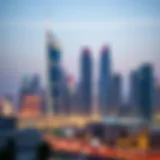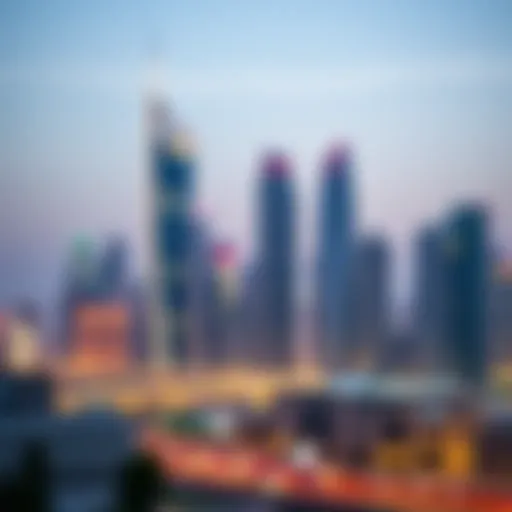Exploring the Financial Aspects of Burj Khalifa


Intro
The Burj Khalifa stands as a testament to human ambition and engineering prowess. As the tallest building in the world, its towering structure does not only shape Dubai’s skyline but also influences the financial landscape of luxury real estate in the region. For investors and expatriates alike, understanding the intricacies of owning property in this iconic edifice goes beyond mere admiration of its architectural marvel. It necessitates a dive into the economic implications that accompany such an investment.
In this article, we will delve into the financial dynamics surrounding the Burj Khalifa, exploring its construction costs, property valuations, and ongoing revenue stream from various commercial outlets. Furthermore, we’ll dissect the amenities and features that define life in this magnificent tower and investigate the neighboring community's lifestyle, accessibility, and appeal. By doing so, we aim to provide a nuanced perspective that not only engages prospective investors but also aids them in making informed decisions in the demanding real estate market of Dubai.
Prolusion to the Burj Khalifa's Economic Relevance
The Burj Khalifa stands not only as a striking architectural wonder but also as a symbol of Dubai's rapid growth and economic aspirations. It is impossible to overstate its economic relevance, considering how it has transformed the financial landscape of the region. For potential investors, expatriates, and real estate agents, understanding the Burj Khalifa’s role in the economy can provide key insights into the broader trends within Dubai’s property market.
One aspect to consider is its pivotal role in boosting high-end real estate demand. When clients think of luxury living, the Burj Khalifa often comes to mind, thus framing the entire landscape of property listings in Dubai. Additionally, the tower’s presence has stimulated surrounding areas, with property values in close proximity steadily gaining momentum. The Burj Khalifa has essentially become a beacon for luxury real estate investment.
Moreover, the economic impact of the Burj Khalifa transcends mere financial metrics. Its influence ripples into the cultural fabric of the UAE, helping to redefine how luxury is perceived in this dynamic market. As a flagbearer of modern architecture, it has caught the eye of global investors, making Dubai a hub for tourism and investment.
This section will delve deeper into the significance of the Burj Khalifa's economic role, starting with its influence on Dubai's real estate market and then exploring its broader cultural and economic impact on the UAE.
Significance in Dubai's Real Estate Market
The Burj Khalifa has continually shaped the contours of Dubai's real estate market. Real estate prices in the vicinity of the tower are often higher than in other regions, which underscores its value from an investment viewpoint. Luxury apartments within the Burj Khalifa command premium prices, drawing in affluent buyers eager to invest in a slice of iconic history.
The tower's stature encourages the development of additional luxury projects nearby, creating a ripple effect that uplifts property values. Investors frequently place their bets on properties located close to this landmark, knowing that its prestige can contribute to sustained appreciation in the long run. As these dynamics unfold, they inevitably form a buoyant market that attracts both local and foreign investments.
Additionally, the Burj Khalifa serves as a crucial marketing tool for Dubai:
- It enhances the city’s appeal as a global tourism and business center.
- The tower's visibility on the world stage creates a halo effect, making other properties seem more attractive.
- Events hosted at or near the Burj Khalifa draw significant foot traffic, further benefiting local businesses.
Cultural and Economic Impact on UAE
Effectively, the Burj Khalifa is more than a collection of bricks and mortar; it represents a broader vision of what Dubai aims to achieve culturally and economically. The tower is emblematic of the UAE's ambition to blend tradition with modernity, reflecting its cultural heritage while embracing the benefits of globalization.
The tower has become a cultural icon. People flock to see its illuminations, attend fireworks shows, or enjoy concerts in its vicinity. This elevates not just tourism but also creates myriad opportunities for local businesses. Hotels, restaurants, and shops benefit from the consistent influx of visitors. Individuals looking to harness this booming market often find unique investment options in businesses that cater to tourists.
The Construction Costs of the Burj Khalifa
The construction costs of the Burj Khalifa stand as a testament not only to the tower's extravagant design but also to its significance in shaping Dubai’s skyline and economy. Understanding these financial aspects provides invaluable insight into how the Burj Khalifa was financed and built, offering valuable lessons for investors and those interested in high-end real estate. From the initial investment to the breakdown of various expenses, examining the costs reveals more than mere numbers; it tells a story of ambition, innovation, and strategic economic moves.
Initial Investment and Funding
The initial investment for the Burj Khalifa was estimated at a staggering $1.5 billion. This hefty price tag underscores the scale of ambition behind its construction. Funds came from several sources, including the government of Dubai and private investors. The financing strategy showcased a blend of public and private investments, aimed to not just build a skyscraper, but establish a monumental landmark that symbolized Dubai's rapid growth and development.
Furthermore, the vision was not just for an architectural marvel but to draw in tourists and business opportunities. Thus, the initial investment was framed as a long-term strategy to position Dubai as a global city. Investors saw this initiative as enticing, given the lucrative opportunities it presented in a fast-growing market.
This financial umbrella was crucial in ensuring that other elements—like cutting-edge materials, advanced engineering techniques, and skilled labor—could be affordably sourced. The coordination of funding illustrated how pivotal collaboration between various stakeholders can be in undertaking massive projects.
Breakdown of Material and Labor Expenses
Diving deeper into the costs, the breakdown of material and labor expenses reveals the technical and logistical challenges involved in the Burj Khalifa’s construction.
- Materials Cost: The choice of materials significantly influenced the project’s overall expense. The tower utilizes reinforced concrete, which alone comprised a large fraction of the budget. An estimated 330,000 cubic meters of concrete were employed, alongside about 103,000 square meters of glass and 15,000 tons of structural steel. The glass, designed for high insulation, not only adds aesthetics but also contributes to energy efficiency, ultimately helping in reducing long-term operating costs.
- Labor Expenses: Labor formed another key component of the construction costs. The Burj Khalifa employed a multicultural workforce, featuring thousands of workers from various countries. They faced not only the technical challenges of high-rise construction but also the extreme weather conditions of Dubai. The total labor cost maintained a balance between ensuring quality workmanship and the efficient progress of the construction project.
- Engineering and Design Fees: Significant expenses were also allocated to engineering and design. The iconic structure's height necessitated pioneering engineering solutions. Firms were enlisted for their expertise in high-rise construction, ensuring that the building could withstand the natural elements while highlighting its architectural intricacies.
The construction costs ultimately reflect a well-planned investment into the foundational aspects of what would become a significant fixture of the global architectural landscape.
"The Burj Khalifa represents not just a tower, but a monument of human ingenuity, financed through a blend of vision, investment, and strategic planning."
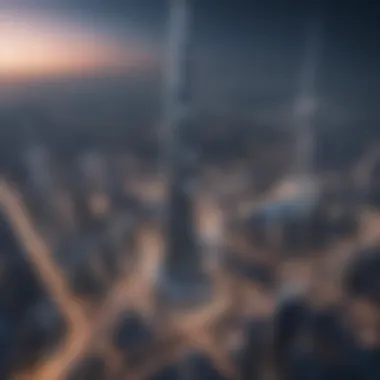

By analyzing these financial dynamics, investors and stakeholders can gain a broader understanding of not only the costs involved in such ambitious projects but also the intricate interplay between vision, investment, and outcome.
Current Property Values
Understanding the property values tied to the Burj Khalifa is crucial for anyone looking into the real estate market in Dubai. This iconic structure isn’t just a marvel of engineering; it stands as a bellwether for luxury property trends in the region. Investors, expatriates, and real estate agents all can glean insights from the pricing dynamics that reflect broader economic conditions and market sentiments. Factors such as demand, amenities, and even the prestige associated with living or working in the Burj Khalifa play significant roles in determining these values.
Luxury Apartments within Burj Khalifa
The Burj Khalifa houses some of the world’s most sought-after luxury apartments. Many are enamored by the idea of waking up to views that stretch to the horizon, coupled with opulent interiors crafted by world-renowned designers. Prices for these apartments often reach dizzying heights, ranging from several million dirhams to more than 30 million dirhams, depending on the size and floor level.
- Exclusivity: Owning a property here is synonymous with status—something that many high-net-worth individuals seek.
- Amenities: The luxurious lifestyle offered comes with top-tier features such as private pools, gymnasiums, and even personal concierge services.
- Long-term Appreciation: Given the history of real estate in Dubai, properties in such high-profile locales often appreciate remarkably well over time.
This allure is enhanced by the notion that residents aren’t just living in an apartment; they inhabit a symbol of modern architectural achievement. According to recent estimates, the Burj Khalifa’s residential units have seen their values steadily rise, making it a prime target for both local and international investors.
Commercial Spaces and Their Valuation
Commercial spaces within the Burj Khalifa are not only attractive for their strategic location but also for the exclusive branding that comes with being housed in the world’s tallest building. The commercial sector includes offices, retail spaces, and hospitality venues, each contributing robustly to the overall economy of the tower.
- Valuation Strategies: The commercial properties are typically valued based on location performance, rental yields, and existing lease agreements. Recent years have shown a tendency for these spaces to command premium rates due to the foot traffic generated by tourism and high-profile events.
- Market Dynamics: Office spaces can range from 2,000 to over 14,000 square feet, with values fluctuating based on floor level and direct visibility. Moreover, the mix of tenants—including multinational corporations—tends to enhance market stability for commercial investments in the tower.
- Retail Opportunities: Retail outlets in the Burj Khalifa aren't just shops; they are part of an experience, fostering high-end brands. The traffic from both office workers and tourists provides a steady flow of potential customers, making these spaces attractive to retailers.
In summary, the property values linked to the Burj Khalifa represent more than mere dollar signs. They embody a nexus of opportunity for investors keen on luxury markets, all while showcasing the dynamics of Dubai’s robust real estate sector.
"The Burj Khalifa isn’t just an investment in property; it's an investment in a lifestyle that few can access."
By focusing on these values, real estate professionals and investors alike can strategically position themselves within one of the world's most dynamic markets.
Operational and Maintenance Costs
The financial fabric of any iconic structure is deeply intertwined with its operational and maintenance costs. Understanding these expenses reveals not just the immediate financial commitments but also the long-term vision of sustainability and efficiency that a towering marvel like the Burj Khalifa requires. It’s important to note that while the initial construction costs are often the highlight, ongoing expenses sustain the building, ensuring it remains a symbol of luxury and innovation for years to come.
Ongoing Maintenance Expenses
First and foremost, ongoing maintenance expenses are critical to preserving the grandeur of the Burj Khalifa. These expenses include regular upkeep, cleaning, and repair works. With a sky-high stature of over 828 meters, the building demands more than your average maintenance routine.
- Scheduled Inspections: Regular checks on critical systems including elevators, plumbing, and electrical setups are paramount. The sheer size of the building means that every repair can be a major undertaking. For instance, window cleaning alone requires specialized equipment and a dedicated team, costing upward of several hundred thousand dirhams annually.
- Property Management: Engaging a solid property management team helps in addressing smaller maintenance issues before they balloon into costly renovations. High-quality property management can foster tenant satisfaction, which is essential in a luxury space like Burj Khalifa.
- Utility Costs: The building's extensive lighting and climate control systems demand significant power, translating to hefty utility bills. The modern design emphasizes energy efficiency, yet the sheer scale means expenses will invariably remain high.
These maintenance expenses are a necessary investment to ensure property value remains intact and to foster a premium experience for residents and visitors alike.
Security and Infrastructure Management
Security and infrastructure management is another layer of operational costs that must be meticulously planned and executed. Given the Burj Khalifa's stature and its symbolic importance to Dubai, top-notch security is not just a recommendation but a necessity.
- Security Personnel: Deploying trained personnel throughout the building ensures a quick response to any disturbances. The location attracts tourists, which amplifies the need for visible and efficient security measures. Guards are stationed throughout, requiring strategic hiring practices to ensure that security protocols are met.
- Surveillance Systems: An investment in advanced surveillance technology, including CCTV, entry scanners, and alarms, establishes a safe environment. These systems require regular monitoring and updates, adding to operational costs.
- Fire Safety Inspection: Updating and maintaining the intricate fire safety systems is a legal requirement, demanding compliance with local regulations. Regular drills and equipment checks help mitigate risks, but they add further layers of cost to the management of the building.
The overall effectiveness of security and infrastructure management greatly influences tenant satisfaction and visitor experience. Together with ongoing maintenance, these components make sure the Burj Khalifa remains not just a stunning architectural feat, but also a sound investment for all involved. Every dirham spent in these domains represents an investment back into the building’s high-standing reputation in the luxury market.
"Investing in maintenance and security is investing in the value of the future, particularly for a landmark such as the Burj Khalifa."
Revenue Generation from Various Ventures
Understanding the revenue generation strategies tied to the Burj Khalifa is essential, not merely for those who have a stake in its operations but for investors eyeing opportunities in luxury real estate. This towering edifice is not only a marvel of architectural ingenuity but also a vital player in Dubai's economy. The Burj Khalifa leverages multiple streams of income that enhance its overall financial viability. These strategies offer both a cushion in fluctuating markets and a roadmap for maximizing returns.
Tourism and Observation Deck Profits
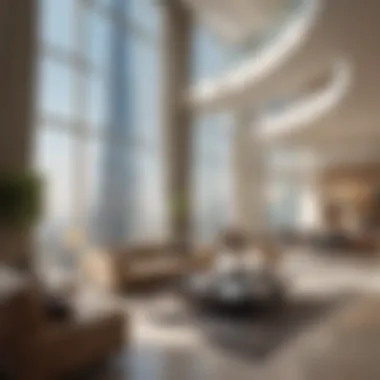

Tourism constitutes a cornerstone of revenue for the Burj Khalifa. Thousands flock to this titan not just for its staggering height, but for the panoramic views it provides from the observation deck on the 148th floor.
- Visitor Numbers: Each year, approximately 1.5 million visitors ascend to observe Dubai from its apex. This foot traffic translates into significant ticket sales. A round trip ticket can set a traveler back about 200 AED.
- Special Experiences: For a fee, guests can enjoy exclusive experiences like dining or evening visits, which further spikes profitability.
- Brand Partnerships: Collaborations with luxury brands for promotional events help attract more visitors. These partnerships boost visibility and provide a unique allure to the experience.
"The observation deck isn't just about views; it's an economic powerhouse that fuels local enterprises."
Considering these elements, the observation deck emerges as more than just a viewpoint—it's a wellspring of capital beneficial not only for the tower but also for the surrounding businesses and hospitality sector.
Dining and Hospitality Revenue Streams
Dining options within the Burj Khalifa are crafted to cater to elite tastes, offering an impressive array of culinary experiences. From high-end establishments like At.mosphere located on the 122nd floor to more casual dining, each contributes to the financial tapestry of the tower.
- Exclusive Dining Experiences: Restaurants lure patrons not only from the building but also from across the city. At.mosphere alone has seen frequent reservations that lead to substantial profits due to its exclusive atmosphere and gourmet offerings.
- Corporate Events & Functions: Hosting corporate functions, weddings, and events can command premium prices, significantly boosting the overall revenues. The Burj Khalifa is often chosen for its unique view and prestige connected to its global recognition.
- In-House Catering Services: Catering to events held within the tower adds yet another layer to its hospitality income. It’s common for guests to opt for full-service catering that includes high gourmet meals complementing the luxurious setting.
This segment of revenue generation illustrates the multifaceted financial strategies that the Burj Khalifa employs to enhance its economic standing continually. Such meticulous attention to detail ensures that it remains a coveted destination for both tourists and local investors, ensuring sustained profitability in an ever-evolving market.
Investment Opportunities Related to Burj Khalifa
Exploring the financial opportunities connected to the Burj Khalifa sheds light on its potential for investors. This skyscraper is not only an architectural wonder; it represents a strategic asset in Dubai's thriving luxury real estate market. With various investment avenues available, understanding these can help investors grasp how the tower continues to attract both local and international capital.
"The Burj Khalifa stands as a beacon for financial growth, symbolizing the intersection of luxury and opportunity in Dubai."
Real Estate Investment Trusts (REITs)
Real Estate Investment Trusts, or REITs, provide a unique way to invest in properties associated with the Burj Khalifa. These trusts allow individual investors to buy shares in a portfolio of real estate assets, which may include commercial spaces or even luxury rentals within the tower.
The major benefit of investing in REITs tied to the Burj Khalifa is diversification. Instead of putting all your eggs in one basket, investing in a REIT allows for a spread of risk over multiple properties. Moreover, these investments generally yield dividends that can provide a steady income stream.
Among the REITs focused on Dubai's market, several are actively investing in upscale developments due to their consistent demand and higher rental rates. This means that even during market fluctuations, there’s a cushion provided by the income generated from luxury properties in prime locations.
Considerations include:
- Market Timing: It's essential to analyze market conditions before investing in REITs.
- Management Fees: Keep an eye on fees, as they can affect overall returns.
- Liquidity: Shares in a REIT can be bought or sold, offering better flexibility compared to direct property ownership.
Direct Ownership of Luxury Properties
Investing directly in luxury properties within the Burj Khalifa could provide unparalleled opportunities, particularly for those looking to dive into the upscale market. Owning a piece of this monumental structure means not just having real estate; it’s about owning a status symbol that demands attention.
The allure of direct ownership extends beyond just the investment perspective. It opens the door to high rental yields. This is particularly advantageous in a location where demand outstrips supply, as many expatriates and tourists seek exclusive experiences that such residences offer.
However, owning property in the Burj Khalifa is not without its challenges. The initial costs are significant, which can deter some investors. Yet, thoughtful financial planning can mitigate risks and enhance returns. Key elements to consider involve:
- Maintenance Costs: High-end properties can come with steep upkeep fees.
- Resale Value: Properties tend to appreciate due to their uniqueness; however, savvy market awareness is crucial.
- Legal Factors: Understanding property laws in Dubai is essential to navigate any complexities in ownership.
The Burj Khalifa, with its striking presence, remains a gateway for lucrative investments. Whether choosing to invest through REITs or seeking to own directly, the potential rewards are substantial for those willing to engage with the unique challenges it presents.
Challenges and Risks of Investment
Investing in high-profile properties like the Burj Khalifa appeals to a specific breed of investor. While the potential for lucrative returns is enticing, the challenges and risks associated with such investments need thorough examination. The Burj Khalifa stands tall not only as an architectural marvel but also as a complex financial instrument. Recognizing the nuanced financial landscape is crucial for both seasoned and novice investors.
Market Fluctuations and Economic Pressures
The dynamic nature of real estate markets can sometimes feel like riding a rollercoaster. Prices tend to sway based on a variety of factors, including national economic growth, foreign investments, and even global events. In the case of the Burj Khalifa, its upscale positioning means it is particularly sensitive to market fluctuations, making it imperative for investors to stay well-informed.
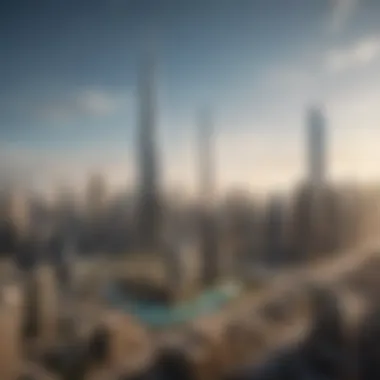

A few key considerations include:
- Supply and Demand: Like any market, the balance between what’s available and what buyers are willing to pay can alter property values significantly. For instance, if extra luxury properties are developed nearby, potential investors might find the competition brings prices down.
- Geopolitical Events: Political instability in the region or changes in international trade can ripple through Dubai's economy. Any shifts here could impact rental demand and property valuations within the tower.
- Economic Policy Changes: Often, changes to local economic policies, such as tax adjustments or alterations in property laws, can influence the overall market environment. Investors need to keep an ear close to the ground to react to such changes swiftly.
Ultimately, understanding market pressures is not just about monitoring trends but also about foreseeing potential challenges that may affect long-term investment viability.
Regulatory and Legal Considerations
The regulatory landscape surrounding high-value properties such as the Burj Khalifa is intricate and can be quite daunting. Regulations govern property ownership, rental agreements, and financial transactions, and any misstep in comprehension can have faced consequences for investors.
Consider these vital aspects:
- Ownership Laws: The UAE has specific laws governing foreign ownership in real estate. Although Dubai has been liberal in allowing expats and foreign investors to buy property, limits may exist in certain areas.
- Zoning Regulations: Zoning laws affect how properties can be utilized. Changes in zoning can lead to restrictions on how an owner wishes to modify or develop their investment.
- Property Management Regulations: Understanding the responsibilities and rights under local property management laws is essential. Failure to comply with such regulations can result in legal battles or hefty fines.
"Navigating the Burj Khalifa's financial landscape requires not only strategic foresight but also astute legal comprehension."
Investors must stay ahead of the curve on these regulatory aspects, as changes can have substantial ramifications on what was initially perceived as a good investment. In summary, the financial landscape surrounding the Burj Khalifa is not for the faint-hearted. While it holds potential for high returns, the associated risks and challenges cannot be overlooked.
Comparative Analysis with Other Luxury Developments
Conducting a comparative analysis with other luxury developments plays a pivotal role in understanding the Burj Khalifa's place within the broader context of global real estate. This section sheds light on several vital aspects: architectural distinction, pricing power, tenant demand, and the socio-economic impact that similar high-rises have on their surrounding environments.
By scrutinizing how the Burj Khalifa stacks up against other iconic towers, real estate stakeholders can better appreciate its competitive advantages and potential investment allure. Such comparisons not only reflect market dynamics but offer deeper insights into future trends that may arise within the luxury property sector.
Comparison with Similar High-Rise Projects
When setting the Burj Khalifa side by side with other high-rises like the Shanghai Tower and One World Trade Center, several noteworthy distinctions come to the forefront. For one, while the Burj Khalifa reigns supreme in height, its architectural style leans towards a traditional Middle Eastern influence, which diverges sharply from the ultra-modern aesthetics of the Shanghai Tower. Each of these structures brings its unique characteristics to the table.
- Height and Design: The Burj Khalifa, standing at 828 meters, is a marvel of engineering, but the Shanghai Tower's twisting design challenges conventional architectural norms, representing innovation in urban vertical living.
- Market Interpretation: Investors tend to perceive not just square footage but demand for luxury living. The prices in Burj Khalifa often soar due to its perceived prestige and exclusivity. Comparatively, new luxury projects in major cities like New York and Hong Kong also attract high-net-worth individuals, fueled by both local and global market trends.
Ultimately, these comparisons illuminate how consumer preferences vary while underscoring the Burj Khalifa’s unique desirability in Dubai’s real estate landscape.
Market Positioning Among Global Landmarks
The Burj Khalifa undoubtedly holds an esteemed spot on the global stage. Yet, dissecting its market position among prominent landmarks sheds light on the strategies employed by developers and how they shape public perception. In this vein, one can draw parallels between the Burj Khalifa and structures like the Eiffel Tower in Paris or the Sydney Opera House.
- Cultural Symbolism: While the Eiffel Tower symbolizes Parisian romance, the Burj Khalifa signifies Dubai’s aspirations and ambition. For prospective investors, recognizing this cultural symbolism plays a crucial role in understanding each landmark’s intrinsic value.
- Visitor Experience: Both the Burj Khalifa and the Taipei 101 encourage tourism through their observatories, enhancing their revenue. However, their abilities to capture visitor hearts cannot be overlooked. An immersive experience is paramount. Thus, a well-designed visitor engagement strategy can significantly affect property valuation and appeal in high-rise developments.
By dissecting how the Burj Khalifa interacts with its high-rise counterparts and market positioning, stakeholders can identify opportunities as well as areas requiring careful navigation. The complexity of such a landscape demands a vigilant and informed approach—especially for investors, expatriates, and real estate agents who seek to capitalize on this dynamic sector.
The Future of the Burj Khalifa in Investment Landscape
The Burj Khalifa stands not just as a towering piece of architecture but as a cornerstone in the investment landscape of Dubai. Even as the world evolves, the relevance of this iconic structure is unlikely to diminish. In fact, as economic trends shift, the Burj Khalifa is poised to continue attracting high-net-worth individuals and savvy investors looking for profitable opportunities in a vibrant market. Its strategic position, ongoing valiant efforts in maintaining and modernizing facilities, and the vision for future developments in Dubai ensure its importance in real estate investment.
Continued Relevance in Dubai's Market
Dubai's economy is a resilient beast, and the Burj Khalifa represents a significant chapter in this ongoing narrative. Even with the challenges brought on by global economic influxes, the tower’s real estate values maintain a steady pace of growth. The luxury market, especially around this landmark, remains buoyed by a unique blend of factors:
- Tourist Draw: As one of the world’s top tourist destinations, the Burj Khalifa attracts millions of visitors yearly, directly supporting retail and hospitality sectors.
- Brand Value: The iconic status of the building enhances the desirability and prestige of properties linked to it, fostering continued interest from both domestic and international markets.
- Steady Demand: High-income expatriates continually migrate to Dubai, keeping demand for luxury residences stable, thereby influencing property values positively.
Maintaining this castle in the clouds means ensuring it evolves along with the market. Investors should look beyond just real estate trends and focus on the Burj Khalifa's ability to adapt to new economic models and consumer demands.
Visionary Projects Ahead for Dubai
The UAE government has laid out ambitious future plans that center around innovation and sustainability. Several visionary projects align with enhancing the Burj Khalifa’s role in this new chapter of Dubai's growth. Here are some notable initiatives:
- Smart City Initiatives: Innovative tech will fuse throughout Dubai, making it a global hub for digital technology—providing both uplift in usage and upgrades in amenities around the Burj Khalifa.
- Sustainable Developments: The focus on sustainability channels investments toward eco-friendly spaces and energy-efficient systems, which can add further allure for those looking to invest in green properties near or within the tower.
- Cultural and Community Spaces: As the area around Burj Khalifa transforms into vibrant cultural hubs, it will foster a community atmosphere that entices residents and tourists alike, directly impacting property values.
The combination of these projects suggests that the Burj Khalifa's future is not only about maintaining glory but about fostering a thriving community, enhancing its investment potential. It’s evident that investors highly attuned to these localized developments can reap significant rewards while contributing to the cultural richness and economic vitality of Dubai.
Investing in the Burj Khalifa isn’t just about the tower itself; it’s about securing a foothold in a rapidly evolving real estate landscape that promises both profits and prestige.
